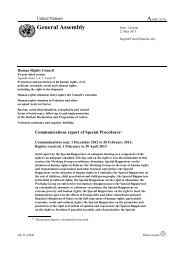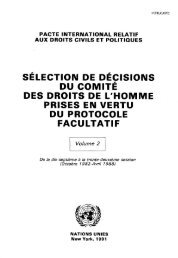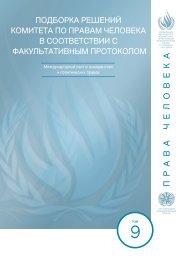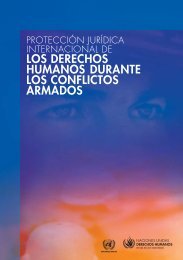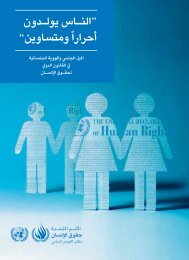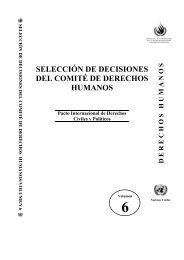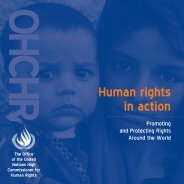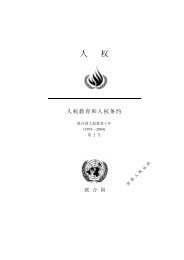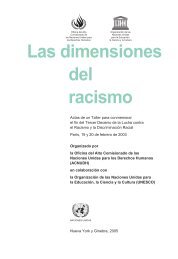good governance practices for the protection of human rights
good governance practices for the protection of human rights
good governance practices for the protection of human rights
You also want an ePaper? Increase the reach of your titles
YUMPU automatically turns print PDFs into web optimized ePapers that Google loves.
inadequacy <strong>of</strong> existing constitutional provisions and <strong>the</strong> potential <strong>for</strong> <strong>the</strong> erosion<br />
<strong>of</strong> <strong>rights</strong> upheld under Australia’s common law, since <strong>rights</strong> and freedoms can<br />
be overridden by Commonwealth, State and local government legislation. Supporters<br />
also pointed out that, in common law, it is difficult to develop general<br />
statements on <strong>human</strong> <strong>rights</strong> derived from individual cases, since <strong>the</strong> courts are<br />
restricted to declarations <strong>of</strong> <strong>rights</strong> regarding <strong>the</strong> parties be<strong>for</strong>e <strong>the</strong>m and need to<br />
be consistent with previous decisions. As a result, <strong>the</strong> <strong>rights</strong> that are recognized<br />
under <strong>the</strong> common law are those left after all <strong>the</strong> exceptions and limitations to<br />
<strong>the</strong>m have been dealt with. The opposition to <strong>the</strong> adoption <strong>of</strong> a bill <strong>of</strong> <strong>rights</strong>,<br />
which was considerable at both <strong>the</strong> federal and State levels, centred on concerns<br />
about <strong>the</strong> potential <strong>for</strong> increased litigation and <strong>the</strong> inappropriate streng<strong>the</strong>ning <strong>of</strong><br />
<strong>the</strong> power <strong>of</strong> judges. Opponents also feared that a bill <strong>of</strong> <strong>rights</strong> would favour <strong>the</strong><br />
<strong>rights</strong> <strong>of</strong> criminals over those <strong>of</strong> victims.<br />
Response<br />
In 2002, <strong>the</strong> government <strong>of</strong> <strong>the</strong> Australian Capital Territory initiated discussion<br />
on a bill <strong>of</strong> <strong>rights</strong> bearing several considerations in mind. First, given that <strong>the</strong><br />
Australian federal and State levels <strong>of</strong> government have different responsibilities,<br />
it was deemed useful to consider a Capital Territory bill <strong>of</strong> <strong>rights</strong>, despite <strong>the</strong> absence<br />
<strong>of</strong> a federal one. Second, it was considered important to include in a bill<br />
<strong>of</strong> <strong>rights</strong> a set <strong>of</strong> unconditional <strong>human</strong> <strong>rights</strong> in order to ensure that <strong>the</strong> Capital<br />
Territory would implement <strong>the</strong>se <strong>rights</strong> in its laws and policies. Also, such a bill<br />
would streng<strong>the</strong>n awareness <strong>of</strong> <strong>human</strong> <strong>rights</strong> in society at large, in <strong>the</strong> legislature<br />
and in policymaking bodies. Third, given <strong>the</strong> strong opposition to such a bill<br />
within <strong>the</strong> Capital Territory, its government initiated an extensive discussion and<br />
consultation on <strong>the</strong> issue.<br />
The Human Rights Act 2004 <strong>of</strong> <strong>the</strong> Australian Capital Territory protects civil and<br />
political <strong>rights</strong>, and is based on <strong>the</strong> relevant standards set out in <strong>the</strong> International<br />
Covenant on Civil and Political Rights.<br />
Design<br />
The government’s strategy leading to <strong>the</strong> adoption <strong>of</strong> <strong>the</strong> Act included a lengthy<br />
period <strong>of</strong> public consultation that allowed <strong>for</strong> community engagement in and<br />
education on <strong>the</strong> necessity and content <strong>of</strong> a bill <strong>of</strong> <strong>rights</strong> <strong>for</strong> <strong>the</strong> Capital Territory.<br />
The government did not present its preferred model <strong>of</strong> addressing <strong>the</strong> question,<br />
but ra<strong>the</strong>r initiated a public discussion on it. An appointed Committee held town<br />
meetings and several consultations with community and expert groups. There<br />
were 49 public <strong>for</strong>ums on <strong>the</strong> issue. The Committee also sought submissions from<br />
<strong>the</strong> public and commissioned a poll <strong>of</strong> selected Capital Territory residents. Such<br />
a consultative process was deemed necessary because <strong>the</strong> proposal to adopt a<br />
<strong>human</strong> <strong>rights</strong> act was subject to significant controversy when it was introduced<br />
to <strong>the</strong> Capital Territory Legislative Assembly.<br />
The distinguishing characteristic <strong>of</strong> <strong>the</strong> bill <strong>of</strong> <strong>rights</strong> is that it establishes a <strong>human</strong><br />
<strong>rights</strong> <strong>protection</strong> process in <strong>the</strong> Legislative Assembly. Be<strong>for</strong>e <strong>the</strong> Assembly<br />
54



